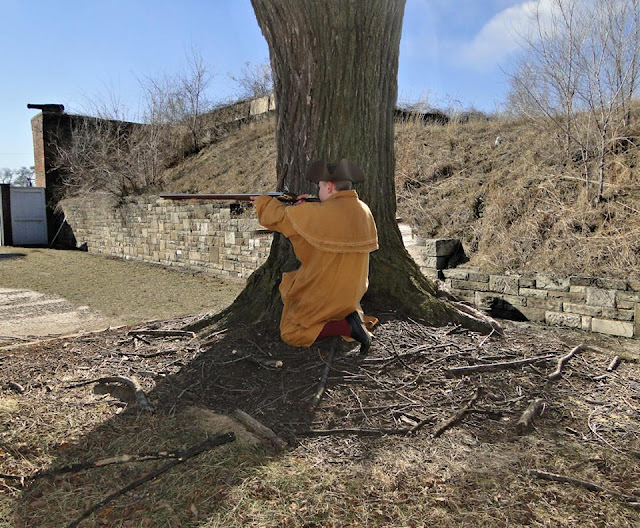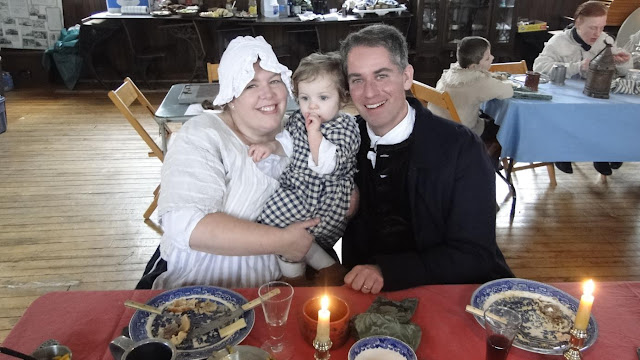 |
I don't know about you, but I can only take
so much of writing in my journal on these
dreary winter days. I need to do something!
|
Unless...unless you know the right people.
I've mentioned numerous times before that we, as living historians, need to stick together and find those with the same like-minded ideas and passions to help make the bleak mid-winter a bit more exciting and fun. This past February here in the metro-Detroit area we've done a couple of things to help stave off the winter blues, and what I did for this week's posting is mesh the two together, including celebrating George Washington's birthday. But before we get to that, please allow me to introduce you to my friend, Tony, who has been a Revolutionary War reenactor for a good many years, starting out with his parents in that great year of history 1976, and continuing off and on through our current time, and now with his own children.
Tony is still in that same military unit as he was back in '76, the 1st Pennsylvania Regiment, though most members from those early days are no longer reenacting. But he is carrying it on here in the 21st century, recruiting new men and preparing for the sestercentennial of the American Revolution. He was kind enough to give me a bit of history of this unit he so passionately portrays:
"In the summer of 1775, not long after the battles of Lexington & Concord and Bunker Hill, the Continental Congress called for the raising the riflemen to go to the aid of Boston. They were trying to figure out the cheapest way to clothe such an army, and hunting shirts and trousers were put forward as a cheap solution. This was the dress of the true frontiersmen from Pennsylvania and Virginia, though it is clear that this was a uniform that was contracted out to be made and issued to the men, not their native clothing. Col. William Thompson, the first colonel of the Pennsylvania Rifle Battalion, appointed Reading, Pennsylvania to be supply depot. The Industrial Revolution had not yet occurred, so the clothing was made, sewn by hand, under contract by suppliers in Reading and possibly other locations. In subsequent years, the army continued to let out contracts for clothes, though tailors who had enlisted as soldiers were brought together to make additional clothes. The men from all the companies of riflemen were instructed to march there where they would receive their uniforms, knapsacks and blankets.
 |
Photograph courtesy of Kerry Dennis
|
The clothing that was issued to the men in the summer of '75 was likely worn out by that autumn or winter, for the men initially marched from Pennsylvania to Boston for about 4 weeks wearing their uniforms, and then served in and around Cambridge until March of 1776, when they marched from there to New York to begin the 1776 campaigns.
They were known as the Pennsylvania Rifle Battalion in the summer of 1775. When Washington reorganized the army, the battalion became known as the 1st Continental Regiment throughout 1776. Washington reorganized the army again in late 1776, and, starting in January 1777, the regiment became known as the 1st Pennsylvania Regiment, and that is the name it fought through for the rest of the war."
I did a bit of research on my own and found that:
Along with the American long rifle, the American hunting shirt became famous in the American Revolution. It was generally made of homespun linen and cut in a long overshirt or wraparound style. It had rows of fringe around the edges and fit loosely so the wearer could move easily. Favored by General Washington, it was frequently worn by both Continentals and the militia. In 1776 Washington described it: "No dress can be cheaper nor more convenient, as the wearer may be cool in warm weather and warm in cold weather by putting on [additional clothes]. . . . "
(Outfitting An American Revolutionary Soldier)
 |
| Tony went around from table to table to answer questions and help or guide anyone in need. |
 |
| Before the sewing began, Tony explained the history of his hunting shirt. |
 |
| Each member received a "kit" that included everything needed. |
 |
| My son was lucky, for his girlfriend, an accomplished seamstress, came along to help him out. |
As I am not portraying military, I didn't make one for myself, though I do plan to possible go out here and there as a Minute Man every-so-often. So after hanging around inside for a while I decided to go out for a while and enjoy a rare, sunny (albeit very cold) February day.
 |
| For the first time ever, I purchased for myself a musket! It is a Gentleman's Fusil Musket - yes, here I am with it. |
 |
| This is the company picture of the gun I purchased. |
"This smooth-bore flintlock muzzleloader has a 36-inch tapered barrel with a .62 calibre bore. The overall length is 52 1/2 inches. The barrel has engraved on it "LONDON" like most pieces manufactured by Kentland gunmakers in the 18th century."
The young man in the following two photos willingly and happily posed for a few shots:
 |
| Though a little too young to be fighting in the War, he is definitely of age to go hunting. |
 |
| Then again, if he sees a Redcoat, he may just take aim! |
 |
| If these two looked cold...they actually were! |
But the fun wasn't over yet - - -
 |
| A toast! Washington's Birthday has a history as old as our country. It was celebrated publicly for the first time in the late 18th century, while George Washington was still president. |
 |
| "Washington's Birthday" became an official holiday in 1885, when President Chester Arthur signed a bill stating so. Meanwhile, there was President Lincoln's birthday on Feb. 12, which never became a federal holiday but was celebrated as a legal holiday in many states outside the old Confederacy. |
 |
George Washington was born in Virginia on February 11, 1731, according to the then-used Julian calendar. In 1752, however, Britain and all its colonies adopted the Gregorian calendar which moved Washington's birthday a year and 11 days to February 22, 1732.
A year and 11 days??
But, how can that be?
|
 |
| George was the oldest son of Augustine and Mary (Ball). His birthplace is located in Westmoreland County, Virginia, at Popes Creek Plantation (also known as Wakefield), with the plantation house, which was probably a simple one, built by his father, Augustine Washington, in the 1720s. Augustine, with his wife (and George's mother, Mary Ball) controlled a plantation of 1300 acres with several outbuildings and twenty to twenty-five slaves from this home. |
 |
| It is unfortunate that the house was destroyed by fire about sixty years later, in 1779. Later, Washington's step-grandson, George Washington Parke Custis, placed a stone marker on the site in 1815 or 1816 commemorating his grandfather's birthplace, explaining, "Here On the 11th of February, 1732, Washington Was Born. |
 |
| Yet despite the holiday often being referred to as “Presidents’ Day” in practice, the official federal holiday is actually “Washington’s Birthday.” When George Washington himself was alive, people honored the occasion with balls and banquets. The celebration continued after his death as a way to remember what America’s first president did for the Nation. |
 |
| For our celebration we had period music played beautifully on the hammered dulcimer. |
 |
| And here is the dulcimer player with his wife and child. |
 |
| Checkers and peanuts - - - - |
 |
| Plenty of talk, mostly about reenactments past & future and historical accuracy of period clothing, muskets, and other items used, abounded. Having a period party doesn't mean one must necessarily stay in 1st person to keep it authentic, just keeping away from modern politics, non-period movies/music, and other contemporary topics. |
 |
| Even though the celebration took place in an 1872 school house, the atmosphere still had that period wooden feel that most modern buildings don't (obviously) have. |
 |
| Most of us brought along our own light. In fact, here are a couple of my lanterns, including my favorite on the right. |
 |
| Together with the members of the 1st Pennsylvania dressed in their 1770s finest, along with most of the rest of us also dressed in an 18th century manner - and throw in the lanterns that helped to complete the ambiance - this 19th century structure certainly did indeed work well as an 18th century backdrop. By the way, this was not my first time participating in such a birthday celebration; ten years ago I was part of a commemoration for the 200th anniversary of President Lincoln's birthday. |
Once again, many thanks to Tony for putting all of this together. It was a really fine time.
Until next time, see you in time.
Sources for this posting:
InfopleaseThe White House
Julian to Gregorian Calendar
Outfitting An American Revolutionary Soldier
And if you would like to know more about George Washington's death Click HERE
Interested in hearing about the beginning of the Revolutionary War from those that were there? Click HERE
Interested in everyday life in colonial times, click HERE
~ ~ ~



No comments:
Post a Comment